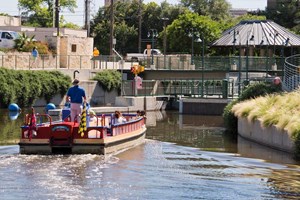WEF Selects San Antonio River Authority, LAN and RESPEC as Recipients of the 2020 Project Excellence Award
(UC) — The Water Environment Federation (WEF) selected the San Antonio River Authority (SARA), civil engineering firm Lockwood, Andrews & Newnam, Inc. (LAN) and integrated solutions partner RESPEC as the recipients of the 2020 Project Excellence Award.
WEF's annual Project Excellence Award pays tribute to excellence and innovation in the execution of projects and programs in the water sector. A panel of judges select projects based on complexity of the water sector problem, future value to the water sector, innovation, sustainability considerations, meeting the owning agency's needs, and contribution to the well-being of people and communities.
In recent years, selection and implementation of Best Management Practices (BMPs) and low-impact development (LID) strategies to address urban runoff pollution have become important components of holistic watershed master planning and stormwater management. However, these strategies have been limited to qualitative planning due to the lack of suitable tools to conduct quantitative assessment. As a result, the effectiveness of the BMP/LID practices could only rely on follow-up long-term monitoring to verify, and there is in general a lack of planning effort prior to implementing BMPs or LID.
To help address these issues and support compliance with increasing water quality regulations, professional engineers with SARA, LAN and software developers with RESPEC (formerly AQUA TERRA Consultants) created a number of innovative water quality modeling tools to allow quantitative water quality master planning and BMP/LID prioritization for several major watersheds in the San Antonio River Basin, including: Salado Creek, Leon Creek, Medina River, and Upper San Antonio River watersheds.
Under the sponsorship and direction of SARA, the LAN team developed the following tools and enhancements:
- SARA Water Quality Modeling Standards to ensure consistent development and calibration of water quality models
- Developed and calibrated water quality models to identify impaired water bodies (locations, timing, and constituents)
- SARA Load Reduction Tool to determine percent load reductions needed to achieve selected screening levels for each of the selected constituents on a sub-basin basis
- SARA BMP Tool to determine the optimal (minimal cost) combination of the types and numbers of BMPs and LID needed to achieve the required load reductions
- SARA LP3 Tool to determine the percent BMP implementation needed to achieve compliance using the statistical Log-Pearson Type III (LP3) distribution
- BMP Ranking Matrix to help evaluate factors impacting the selection of BMP sites for Green Stormwater Infrastructure (GSI)
“These water quality models and tools greatly enhance our abilities to conduct holistic watershed master planning, manage urban runoff, and improve the quality of life of our communities,” said Dr. Sheeba M Thomas Dominguez, P.E., PMP, CFM, senior technical engineer of SARA.
“These tools provide water and river authorities, communities, and stormwater professionals around the country a new and more effective way to address water quality issues in their communities,” said Dr. Ka Leung Lee, P.E., CFM, CPSWQ, senior stormwater engineer of LAN and a key modeler of the project.
Using these SARA models and tools, water quality agencies and stormwater professionals can now determine the optimal combinations of BMPs/LID to accomplish their goals and save substantial stormwater infrastructure and management costs. Already, these efforts have helped improve stormwater management in Salado Creek, Leon Creek, and Upper San Antonio River watersheds. These include identifying priority sub-basins for the development and implementation of BMP siting plans.
Furthermore, the results from these models could potentially help the U.S. Environmental Protection Agency and state agencies to determine BMPs/LID needed to delist impaired water bodies around the country (or to determine if delisting is possible or not using BMPs/LID strategies alone).
In the long run, applying these models and tools will enable water authorities and stormwater professionals to effectively manage stormwater runoffs as close as possible to the source, thereby creating more sustainable watersheds, improving public health and quality of life, enhancing natural habitats, supporting public recreation as well as boosting the local economy.
The award will be presented virtually during the WEF Award Celebration ceremony on Oct. 7th.
Related News
From Archive

- Glenfarne Alaska LNG targets late-2026 construction start for 807-mile pipeline project
- U.S. water reuse boom to fuel $47 billion in infrastructure spending through 2035
- $2.3 billion approved to construct 236-mile Texas-to-Gulf gas pipeline
- Major water pipe break in Puerto Rico hits over 165,000 customers
- Potomac River Tunnel project enters construction phase beneath Washington, D.C.
- Pennsylvania American Water launches interactive map to identify, replace lead water service lines
- Trump's tariffs drive $33 million cost increase for Cincinnati sewer project
- Utah city launches historic $70 million tunnel project using box jacking under active rail line
- Tulsa residents warned after sewer lines damaged by boring work
- Fatal trench collapse halts sewer construction in Massachusetts; two workers hospitalized




Comments